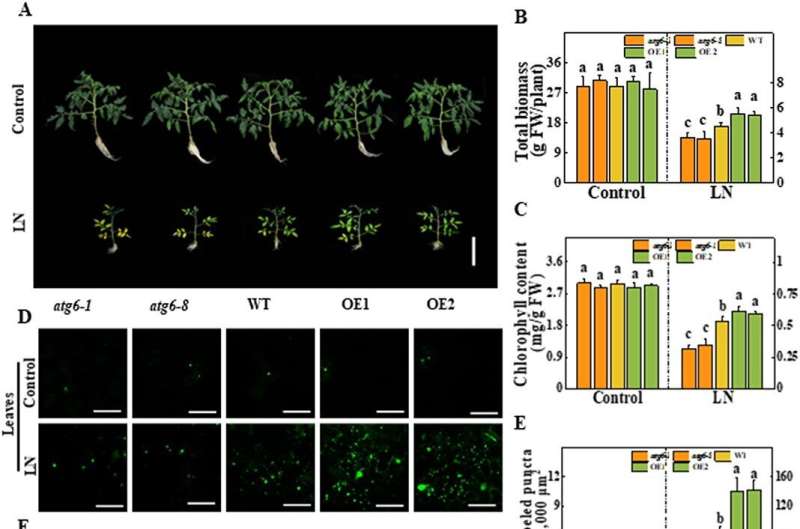How does the autophagic pathway regulate low-nitrogen tolerance in tomato?

Nitrogen (N) deficiency first affects the N uptake and assimilation systems of plants. Nitrate, the main source of plant N, is absorbed and transported by nitrate transporters. Nitrate can be metabolized directly in the roots after absorption and stored in the vacuole, but most nitrate is transported to aerial plant parts. N and carbon (C) metabolism are tightly interrelated in plants. N deficiency affects not only N uptake and assimilation but also C assimilation, especially photosynthesis. Protein degradation for N recycling helps plants adapt to N deficiency.
Autophagy is one of the most important degradation and recycling pathways for proteins and cytoplasmic organelles, and it plays critical roles in nutrient recycling and remobilization under nutrient starvation. Under N-restricted conditions, Rubisco can be transferred to the vacuole and degraded through an autophagy-related gene (ATG)-dependent autophagic process. Although the function of autophagy in internal N recycling has been studied extensively, how autophagy influences N uptake and assimilation and C assimilation processes remains to be investigated.
Recently, scientists from Hunan Agricultural University and Zhejiang Agricultural University reported that the autophagic pathway contributes to low nitrogen (LN) tolerance by optimizing nitrogen uptake and utilization in tomato. First, the authors found that tomato autophagy mutants (atg6, atg10, and atg18a) are hypersensitive to LN stress.
The authors then used ATG6 knockout mutants (atg6) and overexpression plants (ATG6-OE) to further analyze the biological functions of autophagy under LN conditions and found that ATG6-dependent autophagy was essential for the response of tomato to N-limited conditions. Compared with WT plants, the atg6 mutants had lower biomass and chlorophyll content and substantially reduced autophagosome formation after LN stress treatment, whereas the ATG6-OE plants had higher biomass and chlorophyll content and greater induction of autophagosome formation.
Under LN stress, shoot and root N contents of atg6 and ATG6-OE plants were significantly lower and higher, respectively, than those of WT plants. LN-induced expression of the nitrate transporter genes NRT1.1 and NRT2.1 was completely compromised in atg6, whereas their expression was higher in ATG6-OE plants than in WT plants. After LN stress treatment, the activities of nitrate reductase and nitrite reductase in leaves of ATG6 knockout mutants and ATG6-OE plants were decreased and increased to different degrees, respectively, compared with WT plants.
These data indicated that autophagy is involved in N transport and assimilation under LN conditions. Further analysis showed that ATG6-dependent autophagy promotes the assimilation of both N and C and subsequently contributes to plant growth under LN stress. Grafting experiments in which ATG6 knockout mutants were grafted with WT plants as scions or rootstocks further suggested that ATG6-dependent autophagy systematically increases N metabolism, photosynthesis, and plant growth under LN conditions. This work has been published in the journal Horticulture Research.
"Our results reveal new functions of autophagy, i.e. regulating N uptake and utilization as well as C assimilation, in addition to nutrient recycling and remobilization in tomato under LN stress," the authors said. "Intentionally enhancing autophagy may be a beneficial strategy for improving crop growth and yield under nitrogen-deficient conditions."
More information: Jiajian Cao et al, Autophagic pathway contributes to low-nitrogen tolerance by optimizing nitrogen uptake and utilization in tomato, Horticulture Research (2022). DOI: 10.1093/hr/uhac068
Provided by Nanjing Agricultural University The Academy of Science



















